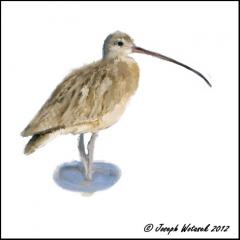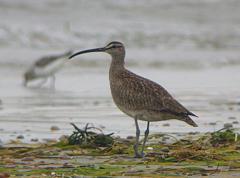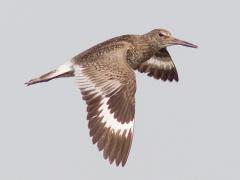Shorebird Project Key Species
Learn more about New Jersey's shorebirds as well as the horseshoe crabs which play a critical role in their survival.
 Zoom+ A black-bellied plover. © Jan van de Kam
Zoom+ A black-bellied plover. © Jan van de Kam
Black-bellied Plover (Pluvialis squatarola) - The largest plover (and one of the largest shorebirds) found in New Jersey, the black-bellied plover can be easily recognized by their black “armpits” when in flight. Their black-and-white dotted backs in winter plumage are noteworthy, but their bold black faces and bellies in breeding plumage are even more striking.
 Zoom+ Dunlin are very common in New Jersey during spring and fall migration. © Mark Peck
Zoom+ Dunlin are very common in New Jersey during spring and fall migration. © Mark Peck
Dunlin (Calidris alpina) - A medium-sized shorebird with a drooping bill, adult dunlin can be easily recognized while in breeding plumage by the large black patch on their otherwise white bellies. Familiar around the world, dunlin spend their winters up and down coastlines across the entire Northern Hemisphere.
 Zoom+ Eskimo curlew.
Zoom+ Eskimo curlew.
Eskimo Curlew (Numenius borealis) - The Eskimo curlew was a shorebird which migrated through New Jersey between its summer breeding grounds in the Canadian subarctic and its wintering range in the Argentinean Pampas. Extinct since 1970, the curlew's sad story is a warning of what may happen if we don't protect the species which still exist.
 Zoom+ Mating horseshoe crabs. © NJDFW
Zoom+ Mating horseshoe crabs. © NJDFW
Horseshoe Crab (Limulus polyphemus) - A species that has changed little in the last 400 million years, the Atlantic horseshoe crab is one of four species of horseshoe crab still alive, but the only one found in the Western Hemisphere. Despite the name, these ancient creatures are more closely related to ticks, scorpions, and spiders than true crabs.
 Zoom+ A red knot in breeding plumage along the Delaware Bay. © Bill Dalton
Zoom+ A red knot in breeding plumage along the Delaware Bay. © Bill Dalton
Red Knot (Calidris canutus) - The largest of the shorebird family known as the “peeps,” the brightly-colored red knot makes one of the longest migrations of any bird in the world. Some populations fly over 17,000 miles roundtrip from the southern tip of South America to their Arctic breeding grounds and back every year.
 Zoom+ A ruddy turnstone searches for food on a Delaware Bay beach. © Mark Peck
Zoom+ A ruddy turnstone searches for food on a Delaware Bay beach. © Mark Peck
Ruddy Turnstone (Arenaria interpres) - A stocky shorebird with nearly unmistakable patterning, the ruddy turnstone can be found all along New Jersey’s coastlines nearly year-round. Though found only in small numbers during the winter, flocks of up to several thousand adults in brightly colored breeding plumage can be found on Delaware Bay every spring.
 Zoom+ Sanderlings (Calidris alba) are a small shorebird that is often seen together in large flocks. They have dark legs and bill. Sexes are similiar and they have a "chunky" appearance with a well rounded body. © Mark Peck
Zoom+ Sanderlings (Calidris alba) are a small shorebird that is often seen together in large flocks. They have dark legs and bill. Sexes are similiar and they have a "chunky" appearance with a well rounded body. © Mark Peck
Sanderling (Calidris alba) - A frenetic feeder, the sanderling is the species that comes to most people’s minds when they hear the word “sandpiper.” Legs flying, sanderling can be seen alternately chasing and being chased by waves as they search for food on beaches worldwide.
 Zoom+ Semipalmated plover. © Jan van de Kam
Zoom+ Semipalmated plover. © Jan van de Kam
Semipalmated Plover (Charadrius semipalmatus) - The semipalmated plover is one of a few plover species worldwide whose numbers are actually increasing thanks to their adaptability and widespread range. A small shorebird with a brown back and a single thick, dark band across its chest, the semipalmated plover can be found foraging on beaches throughout New Jersey for most of the year.
 Zoom+ A semipalmated sandpiper. © Thomas W. Gorman
Zoom+ A semipalmated sandpiper. © Thomas W. Gorman
Semipalmated Sandpiper (Calidris pusilla) - One of several species to pass through Delaware Bay by the thousands in the spring, the semipalmated sandpiper is one of the smallest shorebirds found in New Jersey. Despite weighing just an ounce, these tiny birds will make nonstop flights of up to 2,500 miles during their migration.
 Zoom+ The short-billed dowitcher is a medium to large shorebird with a long bill. © Mark Peck
Zoom+ The short-billed dowitcher is a medium to large shorebird with a long bill. © Mark Peck
Short-billed Dowitcher (Limnodromus griseus) - Unfortunately saddled with a misleading name because of its even longer-billed cousin, the short-billed dowitcher possesses a bill twice as long as its head. Though extremely elusive on their breeding grounds, short-billed dowitchers can be seen regularly on New Jersey’s marshes, mudflats, and beaches throughout the year.
 Zoom+ An adult whimbrel. © Glen Tepke (www.pbase.com/gtepke)
Zoom+ An adult whimbrel. © Glen Tepke (www.pbase.com/gtepke)
Whimbrel (Numenius phaeopus) - A large shorebird with a notably down-curved bill, the whimbrel can be seen feeding on New Jersey’s mudflats, marshes, and beaches during its migration. During the winter, its diet consists mainly of invertebrates, especially crabs, but in summer it will also consume berries and even flowers.
 Zoom+ A willet in flight. © Brian Hart
Zoom+ A willet in flight. © Brian Hart
Willet (Tringa semipalmata) - A noisy shorebird whose piercing flight calls of “pill-will-willet” give it its name, the willet has a conspicuous presence all along New Jersey’s coastlines during breeding season. If you spot a large shorebird with a distinctive broad white stripe on its wings in flight, it can be nothing else than a willet.
Find Related Info: Red Knot, Shorebirds








